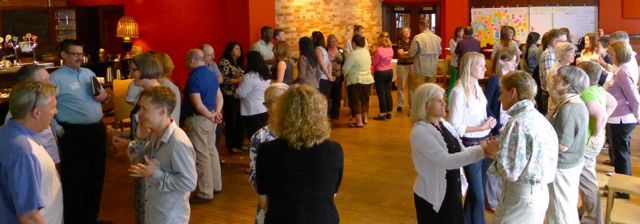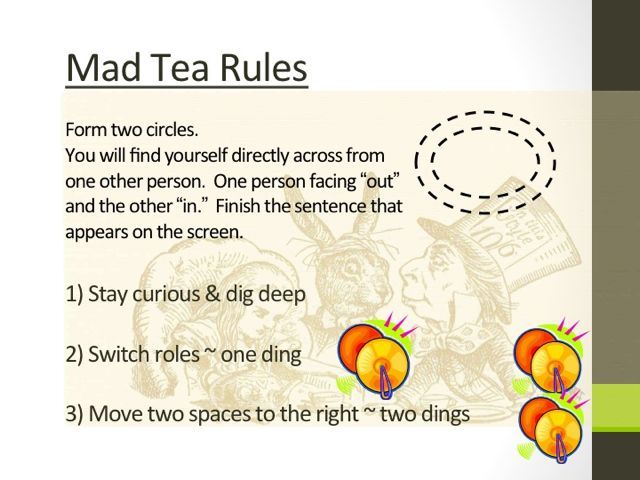{Liberating Structure in Development} Feedback on this LS
![]()
Mad Tea (v1.2)
Rearrange the context for taking action
What Is Made Possible? Mad Tea quickly provokes a deeper set of reflections and strategic insights among group members. The questions focus attention and produce fresh understanding of strategic options and next steps. Participants form two circles, one inside the other. Each person faces one other person and completes an open-ended sentence in less than thirty seconds. When time is up, participants are invited to move to their right so that they are in front of someone else to complete the next sentence, and so on. In a seriously fun way, the unfinished sentences focus attention on every individual and the group answering tough questions together (e.g., If we do nothing, the worst thing that can happen for us is…).
Structural Elements – Min Specs
Structuring Invitation
- You are invited to finish a set of open sentences that relate to shaping your next steps together
How Space Is Arranged & Materials Needed
- Unlimited # people, face-to-face in pairs in two concentric circles
- The inner circle faces out and the outer circle faces in
- Each person is directly across from one other person
- Facilitator projects each question on a screen and dings once to shift the exchange between the pair and twice to shift to a new partner (rotating two people to the right)
How Participation Is Distributed
- Everyone has an equal opportunity to contribute
How Groups Are Configured
- In pairs for each sentence, switching two places to the right as each new sentence appears
Sequence of Steps and Time Allocation
1. [1] Ask everyone in the group to for two concentric circles and find one other person, standing directly across from them, face to face
2. [2] Describe the rules succinctly: in very short order, one person completes the sentence on the screen while the other expresses keen interest and curiosity
3. [1] Invite one person in each pair to finish the sentence # 1 first , ding the bells once at 30 seconds, then invite the other to do the same
4. Ding the bells twice at 1 minute, remind participants to move two to the right (you will not have to remind them after the first round)
5. [12-15] Repeat step 2-4 for each additional open sentence (up to 15 total)
6. [2] Ask, what did you notice about the Mad Tea experience?
7. [5] Invite participants to silently complete the strategy worksheet (below)
Mad Tea Open Sentences
What first inspired me in this work is…
Something we must learn to live with is…
An uncertainty we must creatively adapt to is…
What I find challenging in our current situation is…
Before we make our next move, we cannot neglect to...
Something we should stop doing (or divest) is…
What I hope can happen for us in this work is…
A big opportunity I see for us is…
If we do nothing, the worst thing that can happen for us is…
A courageous conversation we are not having is…
An action or practice helping us move forward is…
A project that gives me confidence we are transforming is…
Something we need to research is…
A bold idea I recommend is…
A question that is emerging for me is…
When all is said and done, I want to...
Something I plan to do is...
 Mad Tea in progress (Toronto, Canada)
Mad Tea in progress (Toronto, Canada)
WHY? Purposes
- Mad Tea brings more life and passion to strategy making
- Reflections, insights, and imagination are enhanced
- Short intervals and pressure to respond quickly reveals essential qualities—without cerebral left brain "interference"
- Responses are stripped of artifice and broken down into simple statements anyone can grasp
- The movement and speed produce magical off-balance moments—one of the gateways to the intuitive
- When the participants mind is emptied of attitude and politically correct responses, you can see everything outside of yourself more clearly
Tips and Traps
- Invite the listener to give all their attention to the answers given
- Keep the time very short for each exchange—20 seconds to 50 seconds for each person in the pair
- Give certain questions more or less time
- Mad Tea can get very loud: be sure you have loud bells or another device everyone can notice easily
Riffs and Variations
- Insert different open sentences depending on the topic at hand (you can make it lighter)
- For example, here is a string developed by Fisher Qua for a team working to improve their performance: I hope to get...from today's session. I know a team is dysfunctional when.... I contribute to this dysfunction by.... Working on ineffective teams makes me.... ...often prevents teams from working well together. A team I worked on that overcame these challenges was.... A practice or behavior we implemented was....
- Bring hats to make Mad Tea a Mad Hatter’s Tea Party
- Use "chat to all" within virtual conferencing technology (it can be lively and fun with hundreds of participants)
Examples
- Part of the opening of any meeting with 20 or more people present
- Use before a more formal conversation about strategy
- Use at the end of any meeting
Collateral Material
Strategy Questions Worksheet
1. What is the deepest need for my / our work?
2. What is happening around me / us that demands creative adaptation?
3. What paradoxical challenges must I / we face down to make progress?
4. Where am I / are we starting, honestly?
5. Given my / our purpose, what seems possible now?
6. How am I / are we acting our way forward toward the future?
Attribution: Liberating Structure developed by Henri Lipmanowicz and Keith McCandless. Strategy Questions inspired by Chris McGoff (The Primes)

